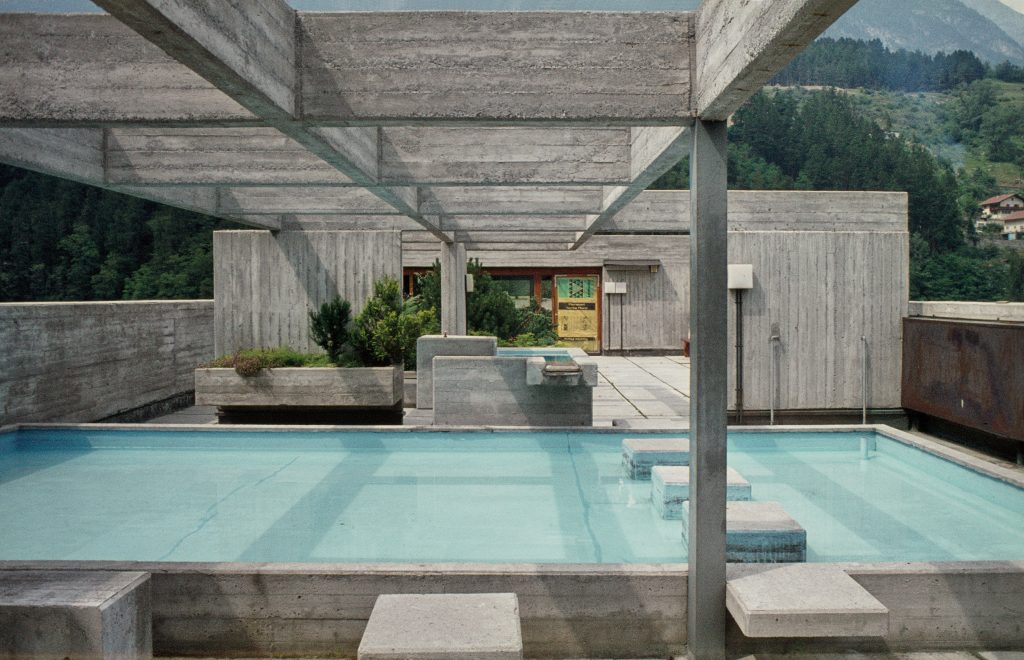
Norbert Heltschl, Mariannhill boarding school, pool on the roof, Landeck, Tyrol, 1964
© Architekturzentrum Wien, Collection, photo: Friedrich Achleitner
Love it or hate it: Brutalist architecture leaves nobody cold. The exhibition ‘SOS Brutalism — Save the Concrete Monsters!’ invites visitors to rediscover a long vilified architectural phenomenon. International examples and Austrian highlights are presented at the Architekturzentrum Wien, shedding light on the architectural and social relevance of these raw, exposed concrete buildings.
Brutalist architecture was completed on all of the world’s continents between 1953 and 1979, often going hand-in-hand with the establishment of the welfare state. Only a few decades later these huge concrete buildings were vilified in many places as architectural eyesores, and left to fall derelict or demolished. Some are still seriously under threat — in Austria, too. “Although there are signs of a current reversal in this trend as Brutalism is re-evaluated. Architecturally, the rhetorical treatment of concrete as a raw material is exciting, while from a socio-political standpoint a desire for built democracy is reflected in many of these buildings,” according to Angelika Fitz, director of the Architekturzentrum Wien.
The online initiative #SOSBrutalism — which has already compiled over 1000 buildings in a database (www.SOSBrutalism.org) — inspired a major exhibition at the Deutsches Architekturmuseum in Frankfurt, which is now going on view at the Architekturzentrum Wien — supplemented by an extensive Austrian section. The first global survey of Brutalist buildings presents examples from Europe, the USA, Africa and Asia. Buildings under particular threat are marked. Unusually large cardboard models and sculptural concrete models convey the fascination of Brutalist architecture. What are the political ideas that formed the context for this international phenomenon? And, how can Brutalism be defined? “The celebration of rawness, that is the moment when Brutalism comes into play. Really, Brutalism is a kind of concrete baroque,” says Oliver Elser, curator of the Deutsches Architekturmuseum.
The extensive collection of the Architekturzentrum Wien provides the resources for a special focus on Austria, in Vienna, enabling us to show great original material. The ten Austrian highlights range from the iconic Wotruba church in Vienna-Liesing, via the already demolished spectacular boarding school tower in St. Pölten, by Karl Schwanzer, to buildings now seriously under threat, like the culture centre in Mattersburg or the congress centre in Bad Gastein. Unknown buildings, too, such as the sadly completely remodelled Mariannhill boarding school by Norbert Heltschl in Landeck, Tyrol, again show what Brutalist architecture is capable of.
“Basically, the history of Brutalism is one big misunderstanding. Many people allow themselves to be put off by its sometimes earie presence, and judge it solely according to aesthetic criteria,” says Architekturzentrum Wien curator Sonja Pisarik. As far back as 1957 the initiators of Brutalism in England, Peter and Alison Smithson, complained in the journal Architectural Design that “Until now Brutalism has been discussed as a style, although in essence it is based on ethics.”
In fact, the buildings often speak of a desire for a self-confident democracy that would bring with it social improvement and a more egalitarian society. The proponents of Brutalism wanted to design cities that enabled social interaction across all class boundaries. Brutalist buildings were often public commissions: schools, university buildings, hospitals, culture facilities and churches.
In 2012 the Architekturzentrum Wien had already made a significant contribution to the rediscovery of Brutalist architecture with the ‘Soviet Modernism 1955–1991’ exhibition and database. In hosting, and with the expansion of, the exhibition ‘SOS Brutalism’ the Az W continues with this work and does justice to increasing interest in the architecture of the 1950s to 1970s, which holds a key position in the Az W Collection. At the same time, about 40 years after their completion these buildings are entering a critical age — in many places the future of these “concrete monsters” in the urban fabric, or their demolition, is often the subject of heated discussion. Although sometimes it is already too late. Both in Austria and abroad, ever more great testimonials to Brutalist architecture are disappearing. In 2016, for instance, an icon of British Brutalism, the inverted pyramid of the Central Library in Birmingham was razed despite strong protest. In contrast, when the boarding school tower (built by Karl Schwanzer, 1965–1972) of the WIFI St. Pölten was demolished in the early 2000s, any outrage was notably absent.
“In the 60s my buildings were awarded, in the 70s they were applauded, in the 80s they were questioned, in the 90s they were ridiculed. Now in the 2000s the ones I like best are the ones that are being demolished”, said British architect Owen Luder. Now, years later, many brutalist buildings are experiencing a veritable hype. The exhibition ‘SOS Brutalism — Save the Concrete Monsters!’ invites a re-evaluation of Brutalism.
A cooperation by the Deutsches Architekturmuseum and the Wüstenrot Foundation, with an additional focus on Austria by the Architekturzentrum Wien.
Curators: Oliver Elser/DAM; Focus on Austria: Sonja Pisarik/Az W
DAM Exhibition design: Rahlwes.Pietz
Az W Exhibition design: Peter Duniecki
Models by: Technische Universität Kaiserslautern, Fachbereich Architektur
